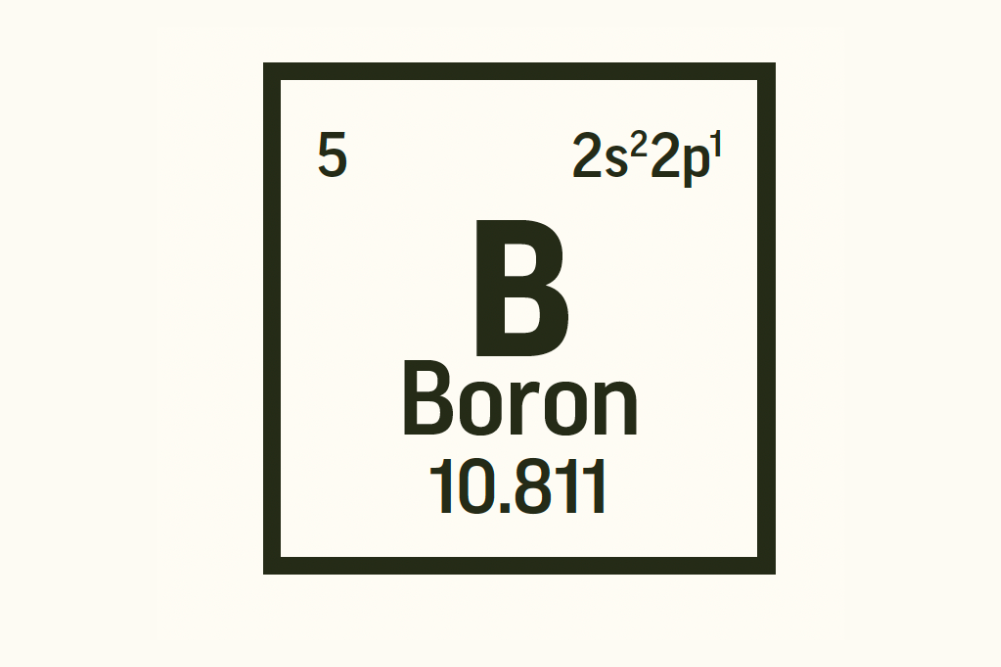Boron is a mineral that has been poorly studied. It has similarities to carbon but its chemical behaviour resembles that of silicon. It is found naturally in its oxidised borate form and, while rare, in the earth’s crust it is concentrated in water and found mainly in volcanic spring waters. There are about 100 borate compounds known.
Boron is a trace mineral essential for plant life. Only recently discovered to be of use to human and animal health, particularly in the regulation of calcium and bone metabolism, it is not yet recognised as essential. Boron is mainly concentrated in the bone, spleen and thyroid in humans and excesses are excreted in the urine. Boron has also been shown to be beneficial for many of the processes of life on earth, including embryogenesis, bone growth and maintenance, immune function, insulin and steroid hormone metabolism, psychomotor skills and cognitive function.
History
In 1777, boric acid was discovered in the hot springs near Florence (Italy), being known as sal sedativum — with recognisable medical benefits. It was not until 1997 that it was used as a supplement.
Boron has multiple industrial uses including glass, magnets, cleaning products, bleaches, insecticides as well as in medicine, and it is a plant nutrient essential for maintaining the integrity of cell walls. Boron is present in foods and beverages as inorganic borates and when ingested is hydrolysed to boric acid in the gut. Boron does not accumulate significantly in body tissues, but bone, nails and hair have higher levels, and fat has the lowest levels. Boric acid is the main form in blood, urine and other body fluids. It is excreted mainly in the urine but also in faeces, sweat, breath and bile. While little is known about its metabolism, 85–95 per cent of dietary intake is absorbed and the body appears to maintain a boron homoeostasis.
Therapeutic uses
Musculoskeletal
Boron is required in calcium and bone metabolism and has been shown to prevent bone loss associated with osteoporosis. In postmenopausal women, boron significantly reduces urinary calcium excretion and increases both oestrogen and testosterone levels. Boron also has an important role in magnesium and vitamin D metabolism, increasing both bioavailability and half-life, thereby helping to prevent deficiencies.
This bone-strengthening function also applies to teeth so boron supplements have been shown to reduce tooth decay.
Anti-inflammatory
Supplementing with boron decreases the inflammatory markers (high sensitivity) CRP (a marker for cardiovascular risk and other chronic illnesses) and TNF.
Neurological
Low levels of boron reduce brain electrical activity, so supplementing improves performance on motor speed and dexterity, attention span and short-term memory. Even short periods of low boron inversely affect brain function and cognitive performance. Boron also reduces heavy-metal toxicity, which impacts adversely on brain function.
Cancer
Research has demonstrated that boron inhibits angiogenesis and induces cancer cell apoptosis. It is also effective against cervical, breast and lung cancers, multi
Boron is essential for the growth and maintenance of bone, improves wound healing, improves the function of sex hormones, reduces inflammation and improves cognitive performance. ple myeloma and non-Hodgkin’s lymphoma. Boron inhibits prostate cancer cell proliferation in men.
Antimicrobial
Boron has antibacterial, antiviral, antiprotozoal and antifungal properties and is often a component of medical antibiotics. Mild solutions of boric acid have been used as eye antiseptics. Boron is also used as a clarifier in swimming pool water treatments.
Food sources of boron
You can find boron in leafy green vegetables, fruit and nuts. Avocados and raisins are particularly rich in boron along with prunes, pecans, peanuts and chocolate powder.
Doses
A 3mg dose of boron per day is generally considered essential but 6–20mg has been used for research. However, be aware that high doses of boron can also be toxic and are associated with cell damage and toxicity.

